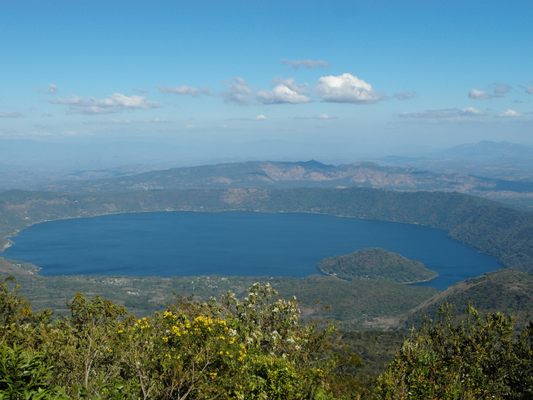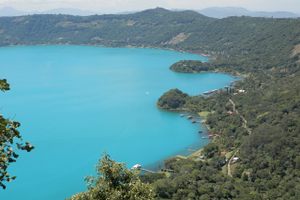About
In the center of a lush and historically volatile chain of volcanic peaks, this caldera lake is home to one of the most scientifically perplexing phenomena on the planet.
Lago Coatepeque, meaning “Snake Mountain” in the indigenous Nahuatl language, is a nationally protected body of water just south of Santa Ana, El Salvador. It’s one of the largest and deepest in Central America. Most often, its geothermal waters are colored a crisp blue. But over the last few decades, the lagoon has sporadically and fleetingly changed its hue—and to this day, experts can’t exactly explain why.
Between 1998 and 2019, the entire lake turned from nearly transparent to a deep, vibrant turquoise in a matter of days multiple times. The event was so stunning to residents and visitors that the crater was named runner-up as the eighth wonder of the world. There is plenty of ongoing speculation, but the mysterious and sudden tinting of Coatepeque’s waters could be due to any combination of things.
Some say that seasonal freshwater rains in June and July stir up volcanic sediment deposited at the base of the lake. When these minerals rise, they prevent sunlight from reaching the depths below, temporarily altering the microbiome and allowing a bloom of a type of algae that absorbs blue light. Another idea is that a buildup of contamination from human settlements and runoff from agricultural practices contribute to changes in the lake’s color and clarity.
It’s even been proposed that it’s the result of an illusion—that summer’s longer days have a bleaching effect on the flora that makes slight shifts in hue more stark to the human eye. This theory doesn’t hold as much water, however, because satellites have successfully captured these unexpected differences in Coatepeque’s surface color.
Related Tags
Know Before You Go
This dramatic occurrence continues to leave us curious, particularly because the chances of catching the spectacle in action are unpredictable. But if you’re set on getting a first-person glimpse of this natural marvel, plan to stay at one of the many hotels situated on the surrounding volcano slopes—the shores are entirely privately owned and not accessible to the public.
Published
November 12, 2024
Sources
- https://www.diariocolatino.com/ues-desarrolla-tercer-muestreo-agua-lago-coatepeque/#google_vignette
- https://diario1.com/nacionales/2024/03/marn-pide-no-banarse-en-lago-coatepeque-por-presencia-de-microalgas/
- https://www.seattlepi.com/national/article/the-votes-are-in-the-eighth-wonder-of-the-world-4960673.php






















